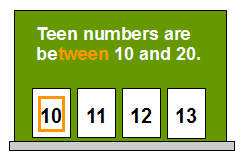It is very common for young students to have difficulty with the numbers 11- 19. Their names do not follow the common rule and they are the sight words/ numbers of mathematics. Teachers must ACTIVELY help students develop meaning for both the words and the corresponding numerals. It may help to emphasize that the teen numbers are between 10 and 20.
Do some informal assessment to decide where to begin on this continuum:
Rote Counting:
- Identify the student's comfort zone: add 1-2 numbers at a time to the 1-10 sequence until the student can reliably count on using the correct names.
- Sing songs and extend counting songs: for example, Ten Little Indians can be modified and extended to be 11 little, 12 little, 13 little teddy bears (or dinosaurs or valentines, etc.). Singing is great reinforcement for many students and helps them acquire fluency with these extended numbers more easily than simply counting aloud. [Think about the A-B-C song for learning the alphabet.]
- Who Has The Number?: Give students the large demo-size cards (#10-20) and have them hold up the cards as you sing the song so that students hear and see the numbers.
- Teen Line-up: distribute the large demo-size cards (#10-20) and ask students to line up in the correct order. NOTE: numbers 10 and 20 of the teen demo cards are boxed in bright orange [see picture above] to visually reinforce the notion that the teen numbers are between 10 and 20. Reinforce this notion often when working with the teen demo cards.
- Build the Hundred Board: students need to build the hundred board by placing the numbers or tiles in the correct order. Again, build slowly by varying the number of tiles the student uses to match the individual comfort zone of each student. Alternatively, print out small number cards, attach magnetic tape, and use metal surfaces such as heaters, sides of file cabinets or cookie sheets so that students can build the hundred chart with these number cards.
- Classroom Applications: Have student perform classroom duties which support the development of one-to-one correspondence: attendance head count, passing out/collecting papers, paper plates, napkins, etc.



No comments:
Post a Comment